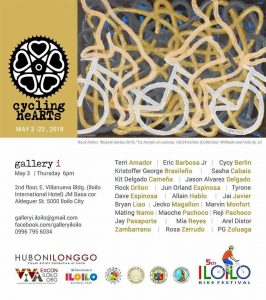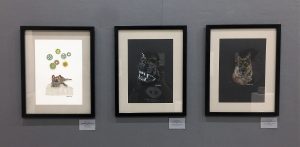Now on its third edition, Cycling heARTs is making history as an art affair in the yearly calendar parallel with the holding of the eventful annual Bike Festival in Iloilo City.
Cycling heARTs underscores the indescribable union of biking and art, a “marriage” tried and tested across time and with various materials that serves as an evidence – prints, photos, billboards, posters, postcards, and, yes – paintings and art installations.

The collection served as a significant footnote on how Pablo Picasso immortalized biking in art through his work the “Bull’s Head” (1942) done from found objects composed of rusty bicycle seat and a handlebar or the replicas inspired from Marcel Duchamp’s “Bicycle Wheel” (1913) from his experimentation that ended up as a work of art.
Fast forward today, much can be seen, absorbed, and told about biking and art in Cycling heARTs since debuting as a collateral event for the Bikefest in 2015 in Iloilo City.
HeART in the fest
Having its own mise-en-scène, the Cycling heARTs has brought depth on the discourse as both artist-biker and enthusiasts rob elbows at Gallery i to discuss art pieces that were conceptualized from their biking life and molded by perceptions from experience and observations.
Considering their varied backgrounds and disciplines, the participating artists offered a range of perspective by bringing into the art space their interpretations from the scientific up to engineering and from personal going inward to the spiritual.
By using different techniques, it amalgamated semantics and jargons that are usually tackled during scientific dialogue, academic debate, or exchanges of historical analyses in order to bring up subjects for the audience to contemplate on.
The exhibit has naturally gelled with various art events in the week-long summer Bikefest which culminate each year with a Grand Fun Ride joined by thousands of bikers from the city and neighboring towns and provinces. The festivity is a celebration of solidarity, advocacy, art and creativity; and livened up by fun and laughter, exchange smiles, high fives, and selfies.
Hence, Cycling heARTs is intellectually engaging and educational for the audience. The approach by artists to go beyond the visual appeal and direct viewer’s curiosity for more elaboration on the subject matter provided valuable transfer of learning and it enriched art appreciation.
Dreaming of Green Gear
Unassuming in one corner are the three works by Terri Amador. All framed in black, two of the three 9 x 12 inches work invited curiosity primarily by the artist’s medium of choice – colored pencil.

A self-taught artist who started to seriously draw pets as portraits, Amador’s works are representations of her “three greatest loves: paper, dogs, and biking,” she shared.
Her works entitled: Dreaming of Green Gear, Chain-Marked: Biker for Life, and Conquer your Fear, all presented pet dogs intertwined with biking with a French Bulldog thinking of bicycle gear like on a dream state, dog fur shaped like a bike, and the artist’s confrontation with self-doubt.
With pets and biking, the works of Amador introduced another facet of human passion – caring for dogs, a dependable partner at the household both by women and men. The biker and the pet dog in Dreaming of Green Gear may have showed the closeness of dogs with their biker-masters up to the point of sharing a dream for an environmentally-friendly mode of transport.
Fire in the Belly
Another fascinating work is Fire in the Belly by Jay Pasaporte.
A viewer whose main affection is on wood will be allured by the 21.5 x 38 inches assemblage with woodworks accentuated by ornate carvings like accents from old houses and antique furniture. Initially, it interrogates the mind on how an art piece made mainly of pieces of wood could be related to biking.
But mystery made Pasaporte’s assemblage a treasured art work as a result of the artist’s inquisitiveness and it urged the viewers to search for interpretations and answers.
The Fire in the Belly literally reflected the artist’s ‘ambition and determination’ to own a bike since he was a kid. The whole piece is put together by seven sub-frames that narrate the artist’s journey toiling on a range of menial to skilled labor in his bid to save money in order to assemble a bike and realize a dream.
“My aspiration to own a bike was characterized by real-life humps and bumps – buying every part hoping to finally assemble a bike,” laughingly recalled Pasaporte.
“I have labored as a water carrier as such you see a faucet in the piece. I handled different goods by loading and unloading them like a longshoreman. I even washed sacks, just to earn money and save for my dream bike,” he pointed out, “but most of my savings also went to other basic necessities that were essentials for everyday life.”

It was not until high school that Pasaporte touched one which he can call his own after his teacher gave him a bike.
A civil technology graduate, Pasaporte now owns around 10 different bicycles which he now shares with his brothers, cousins, and nephews. “It feels good to share and to see them enjoy biking. It gives me a feeling of contentment and reassurance that they will enjoy it without having to go through the agony of hardship that I underwent,” he said.
The intricate detail in his assemblage implies the many events that transpired along the way in his life but which all ended in success and resulted to happiness.
Whose desire line is it, anyway?
Innovatively titled and thought provoking is the work by Reji Pachoco which posed a question: “Whose desire line is it, anyway?”
The answer may be found after closely viewing the detailed lines engraved on the blocks formed by using Plaster of Paris that illustrate an Iloilo City road network done on a scale of 1:4:00. The artwork stirred animated discussion among viewers during the opening of the exhibit as to where Gallery i was located and why colored lines were few.
The map showed the big picture for it highlighted the details with selected colors. The “the green lines represented the current cycling infrastructure while other colored lines represented the routes of various trips that can be taken coded in blue (for grocery), red (for work), and yellow (entertainment),” shared Pachoco regarding her illustration.
In this 24 x 40 inches mixed media representation, she explained that “the infrastructure basically serves the needs of the users” so ideally “all trips should be within the green line.” Yet the work hinted how negligible the current green lines established in Iloilo City. It may also have suggested potentials for green road infra investment.
But Whose desire line is it, anyway? is a work that offers a fitting question to the viewers, road users and urban planners. It jolts the mind to examine the current state of chaos of our traffic system and why our roads are on disarray. Is it a problem of financing and investment, governance, political will, attitudes, low road literacy, or space or the lack of it?
Being an artist and advocate on sustainable practices, Pachoco brought into the art sphere her competence in the science of urban planning by underscoring the elements that must be integrated in building a green city: sustainable transportation, inclusive mobility, pedestrian safety, and creation of green infrastructures.
The work re-orients the mind by cleverly penetrating the subconscious to urge the individual viewer to define its “desired line” for a collective purpose and creating new awareness on the process.
The work by Pachoco cross-examines our own conventional practices and it challenges the viewers with a question on why we need to also transform our views, beliefs, and attitudes being constituents in attaining societal development.
Trip die
Trip die is a 5-inch cast concrete cube by Kit Delgado Cameña. Shaped like a dice, it is big enough for a table game with spray-painted sides that offer six icons that represents the modes of transportation.
Each side of the concrete cube represents the modes of transporting people in the city: walking and bicycling (non-motorized transport or NMT); bus as public transit; taxi (as paratransit having no fixed route); the private car or vehicle (personal motorized option); and, and the motorcycle (a “stepping stone” personal motorized option),” said the artist.
Notwithstanding its exaggerated size, the viewer can roll the dice and chances are high that a bicycle could be selected as a mode of transport.
“In transport lingo, getting from Point A to Point B, is called a trip,” explained Cameña.
“With each trip, the passenger chose at least one mode of transportation, or perhaps a combination of different transport, or probably all 6 before reaching a destination,” he illustrated.
But “if choice on mode of transport will brought by a toss of a dice, Cameña stressed, “one in every six trips will be made by bicycling – a mode of transport comparable with those called bicycle cities like Copenhagen or Amsterdam.”

Trip Tie is a cunning depiction of “playing with chance” only to increase the chances of bicycle use in an urban center that tries to build a reputation worthy to be called a “bicycle city.”
“In reality, however, trips made by using bicycle are likely less than 5 percent,” Cameña underscored, “because a lot of development should be made beforehand, especially on the area of policy and infrastructure, before a bicycle becomes the preferred choice of urban transport.”
“If most Ilonggos share a vision of creating a sustainable city, then bicycles should be at the top of the priority,” stressed by the artist.
Ojo de Dios
Colorful and with a message endearing to the heart of both artists and bikers, the installation work by Maoche Pachoco entitled: “Bike Fest” brings history lesson and a collective message of faith and prayer.
A collector’s item from the third edition of Cycling heARTs, Pachoco’s art installation is called “Ojo de Dios” – synonymous with the Huichol Indians from the mountains of Mexico. “I used Ojo as an approach,” shared Pachoco, to generate a look similar to the bike wheels even from afar by using different colors to show how beautiful the Iloilo Bike Festival is.”

It means an “Eye of God,” an Ojo de Dios is an object mounted on wooden sticks held by a pattern that forms a shape similar to a spider’s web using colorful yarns. Among Huichol Indian people, the center of the pattern is considered an Eye of God; therefore, an Ojo displayed on their homes is treated as a spiritual object.
The same function and message is carried by Pachoco in her work. Yet instead of wooden sticks, she innovated with the material by using bike spokes to create her desired pattern held by a driftwood which she painted with the colors of the skyline that hovers over the bike lane at the Diversion Road that she captured in mind.
“For me making an Ojo for the Bikefest is like inviting God to watch over you; to watch over the bikers who joined the Bikefest, and for the safety of all bikers using the road everyday,” explained Pachoco about her presentation.
Collection on exhibit
The more than 20 collections by 23 artists housed at Gallery i from May 3-30, 2018 is described by Ilonggo artist and bike advocate Rock Drilon as an exhibit “meant to balance meaning of how we perceive biking, not just its union to sports, but more than anything, to mobility, tourism, creativity and art.”
Cycling heARTs solidified its rightful place by becoming an “official event of the 5th Iloilo Bikefest,” stressed Drilon, vowing to the continuity of biking and art and art in biking. You will find the following works by the artists at Gallery i:
- Arel Zambarrano – The Colors of Hindrance, 24 x 40 inches, mixed media.
- Eric Barbosa, Jr. – Simple Machine, 13 x 17.5 mixed media.
- Allain Hablo – Morning Ride and Night Ride, 12 x 16 inches, mixed media, two recent works by the artist.
- Rock Drilon – Bicycle Series 10, 10.5 x 14 inches, mixed media. Exhibited from the collection of Vida and Wilfredo Sy, Jr.
- Brian Liao – Concavos, 34 inches in diameter, mixed media.
- Jason Delgado – Chain Reaction, 20 x 16 inches, mixed media.
- PG Zoluaga – Route 69, 24 x 18 inches, mixed media.
- Jun Orland Espinosa – Gumon sa Reklamo, 24 x 24 inches, wood and metal.
- Mating Namo – The Cyclist, 18 x 21 inches, acrylic on canvas.
- Sasha Cabais – The Wheel, 24 x 24 inches, acrylic on canvas.
- Cycy Berlin – Keirin Princess, 30 x 20 inches, acrylic on canvas.
- Tyron Dave Espinosa – Lakbayin sa Ilang, 21 x 14 x 9 inches, wood and steel.
- Jai Javier – Bike Ville, 20 x 30 inches, pen and ink on paper.
- Jecko Magallon – Moving Forward Plus Balance, 36 x 36 inches, mixed media.
- Kristoffer Brasileño – Parada, 30 x 24 inches, oil on canvas.
- Mia Reyes – Sulodnon Siklesta, 36 x 24 inches, acrylic on canvas.
- Marvin Monfort – Mad Millennial on Bike, 8 x 10, mixed media.
- Rosa Zerrudo – B.I.G.A. (Bike Interactive Guerilla Art) ni Inday, installation, size variable. Done by the artist in collaboration with FAMO and the women artists of Iloilo City District Jail-Women’s Dormitory.
The Cycling HeARTs has flashed a green light that indicate how much awareness was by far attained from previous events. It also showed consistency and steadfast commitment among Iloilo network of bikers and artists-bikers who are organizers of the 5th Bikefest.
The event has definitely evolved and it reflected Iloilo City’s progressive art and biking community and a show of force by bikers and artists who are shaping as a sector fast becoming influential in the push for art engagement, inclusive mobility, and in promoting sustainable urban life and a balanced well-being.






